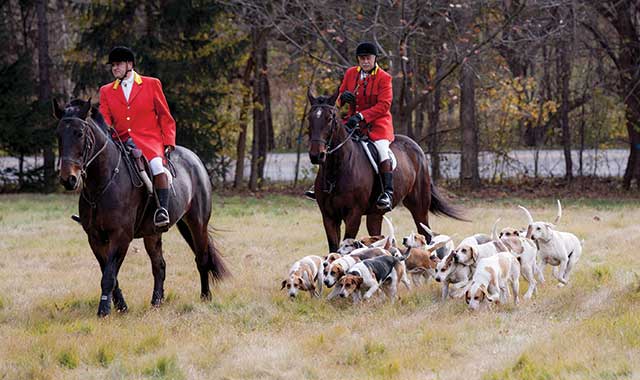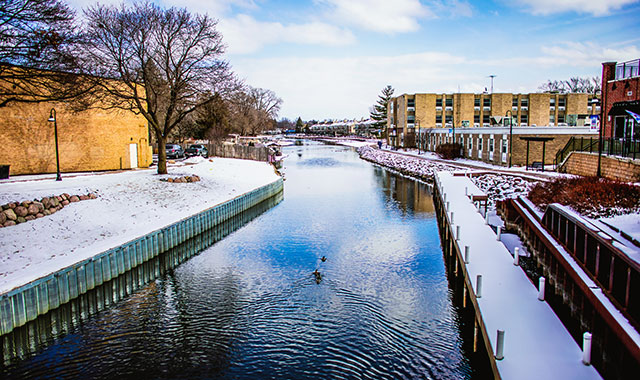Foxes are seldom harmed during a Wayne-DuPage Hunt Club gathering, but these equestrians still enjoy the thrill of the chase in this sport with deep English roots.

Early in the morning, when the hunt master’s horn blasts, red jackets flash across the landscape and dozens of hounds lead their hunting party across the open prairies of northern Illinois.
The colorful, centuries-old tradition of fox hunting – or, in this case, hunting just the scent of foxes – is carried on by Wayne-DuPage Hunt Club (WDHC), with three or four hunts every week from September to December. The volunteer-based group is active in Kane and DuPage counties, where members hunt in public forest preserves and private lands.
Although the sport has evolved over the years, fox hunting is still very beholden to its English roots – a tradition that participants agree is worth preserving. The hunt gives riders a sense of freedom, as they gallop through the fresh morning air, but most of all, the hunt endures for the love of the horses and hounds.
“It’s fantastic to watch the hounds at work, moving in unison up and down the hillsides,” says Patricia Spiroff, a hunter and secretary of the WDHC board of directors.
Spiroff’s horses, Capstone and Bentley, are treasured animals and are expert hunting horses. Spiroff celebrates the sport each November and hosts a “stirrup cup,” or outdoor Champagne reception and brunch.
Honoring Traditions
One should never call the hounds simply “dogs,” says Spiroff, because this is a special breed of dog, distinguished by its long face and large, floppy ears. Hounds are housed in communal kennels and trained by an experienced hunter from the time they are puppies. They learn to pursue their prey by sight and scent, and take long walks each morning with a volunteer as part of their training. When the hounds retire, they usually become house pets.
According to the 1,000-year-old English tradition, packs of hounds track hiding foxes. But in this hunt, actual foxes are seldom involved. The WDHC practices “drag hunts,” a technique that uses only the scent of fox.
“A lot of hunts are live hunts, where they search out coyote and fox,” says Marge Brown, a WDHC member. “We don’t do that. We go out in front of the hunt and have bottles of fox scent, using urine. Depending on the weather, the master of the hunt will sometimes put gin or vodka into it.” Adding alcohol to the scent can keep the trail viable in rainy weather.
During a WDHC hunt, volunteers drop the scent through the woodlands and open fields about an hour before the dawn start time. Once the hounds catch the scent and “speak” that they have the trail, they excitedly follow the scent. A rider called a “whipper-in” keeps them in line by cracking a whip on the ground.
Occasionally, a real fox is caught by the hounds, though it’s rare. “Usually the foxes outrun the hounds,” says equestrian Lance Beaulieu.
A longtime member of the WDHC, Beaulieu also rides with Massbach Hounds and Fox River Valley Hunt, a hunt group that’s based near his home in Elizabeth, Ill., and has ties to northwest Chicagoland.
Hunting can be hazardous. Many a rider has fallen or been injured when a horse is “spooked” by something unexpected, such as a snake, a fallen tree or a large bird that flies too closely. One rider’s horse recently reared up when it came upon a bees’ nest. The rider fell into the nest and received multiple stings.
Because of these dangers, hunt clubs call on local churches to offer prayer services and blessings each fall, to mark the beginning of the hunting season. The annual Blessing of the Hounds, in front of Wayne’s historic Little Home Church by the Wayside, recognizes the hounds, the riders and the foxes.
The event at the 150-year-old church draws dozens of riders with their packs of hounds. The spectators include local residents, retired hunters and a number of tourists, all eager to see the riders arrive in their colorful hunting outfits.
The hunters, wearing smart black hats (top hats, derbies or velvet-covered helmets) and black boots polished to a high sheen, move slowly down the country lane to the church, seated upon their horses with the hounds at their heels.
The blessing often marks the start of the hunting season, when riders may begin to wear their formal attire. Men wear red jackets (called pink coats) with white breeches (called jodhpurs)and yellow vests, while women wear black jackets and tan jodhpurs. Any hunt held before the blessing is considered informal, so riders usually wear brown or beige-colored outfits.
The Rev. Dr. David Russell sprinkles holy water on the riders and hounds, and prays.
“For all animals, especially those in whose companionship we find joy and health,” the pastor recites.
“There’s a longstanding connection in Wayne among the riding community, the church and the hunt,” says Jane Shelton, of St. Charles. “The Blessing of the Hounds has been going on for years and years. It means of lot because hunters take the care of their animals very seriously. The blessing is for the riders, the hounds and the dear fox.”
Mary Roach, of Chicago, is a regular spectator at the Blessing of the Hounds. She has childhood memories of her family’s participation in the WDHC hunts near St. Charles. Roach returns here each year to relive those memories.
“The hunt is beautiful to watch,” she says.
Control is especially important when riding through unfamiliar terrain and successfully jumping a log, leaping a stream or clearing a gate.
Roach’s family would hunt together and jump logs, hedgerows or gates three or four abreast. If they couldn’t jump a gate together, they would open the gate and ride through, being careful to close it again so the next rider could attempt the jump.
Good manners are important to these hunters. A horse who is misbehaving is kept at the back of the hunting party, for the safety of all. If a gate is broken during a jump, riders promptly return to make the repairs or donate a replacement.
Enthusiastic Riders
A horse may have the speed of an American Pharaoh, but that doesn’t make it a hunt horse. It must also be smart and have the heart of a hunter.
“Fox hunting requires a very special horse,” Brown says. “Not only do they have to travel strange ground, they have to be nice to each other. We consider our fox-hunting horses the best in the world.”
These horses are often crosses between draft horses, thoroughbreds and quarter horses. It’s often the horse’s lineage that makes a difference, regardless of the breed. Many hunters seek out horses whose sires were champions.
“Most hunters choose mixed-breed horses to develop the special skills needed for hunting,” says Brown. “The breeds are all over the board. It’s the brains we’re looking at.”
Beaulieu estimates it can take six months to a year to train a hunt horse, in a process that requires much patience. The animal needs to be accustomed to riding beside hounds and navigating difficult territory. A rider since childhood, Beaulieu’s horses Milestone and Rambo are descended from national champions.
“You need to look them in the eye to bond with them,” he says. “You have to get to their heart to know what they’re thinking. Then, they will know what you are thinking.”
He adds: “Tell them something smart, and they know it; it blows you away.”
Hearing the Master’s Call
The Master of Foxhounds is considered “The golden tread connection” between the riders and the hounds.
A master is expected to sacrifice personal time to arrange a hunt, to be a leader of people and animals, and to live by a time-honored code of ethics that identifies him or her as a gentleman or lady.
When the master blows the horn, the hounds respond. One signal tells them to start the trail, another tells them to gather together if the trail is temporarily lost, and one long blast signals that the hunt is over.
Some hunting packs have as many as 60 hounds, but if the master has at least 10 hounds around his horse, he will say, “We are all in,” and the hunt begins. Once the hounds have found the scent, they disperse with their noses down and begin making “hound music.”
Organizing and executing a hunt takes much work by WDHC’s nearly 80 riders and 85 social members. The club owns about 500 acres, but members also work closely with local nature preserves, helping with the seeding and the upkeep of 40 miles of trails.
“We probably spend 30 hours a week in the summer working in the forest preserve, maintaining the forests,” says Fred Iozzo, current Master of the Foxhounds. “The club is hunting on more ground now than in the 1930s, ‘40s and ‘50s, and we’ve brought much land back to its natural state.”
Iozzo spends 25 to 30 hours a week at the club, where he’s been a member for 25 years. He won the volunteer of the year award in 2014.
“I just love hunting, riding across the fields – the hounds, the noise,” he says.
Board member Elizabeth Bramsen, whose family has a long history with the WDHC, finds the hunt a liberating experience.
“In Wayne, we have a wonderful freedom,” she says. “There are very few places in the United States that have open land like this and have a big grass area. It’s very unusual.”
The fox hunt may seem reminiscent of something from TV’s “Downton Abbey,” but this tradition is the real thing – and the tradition rides on.





















































